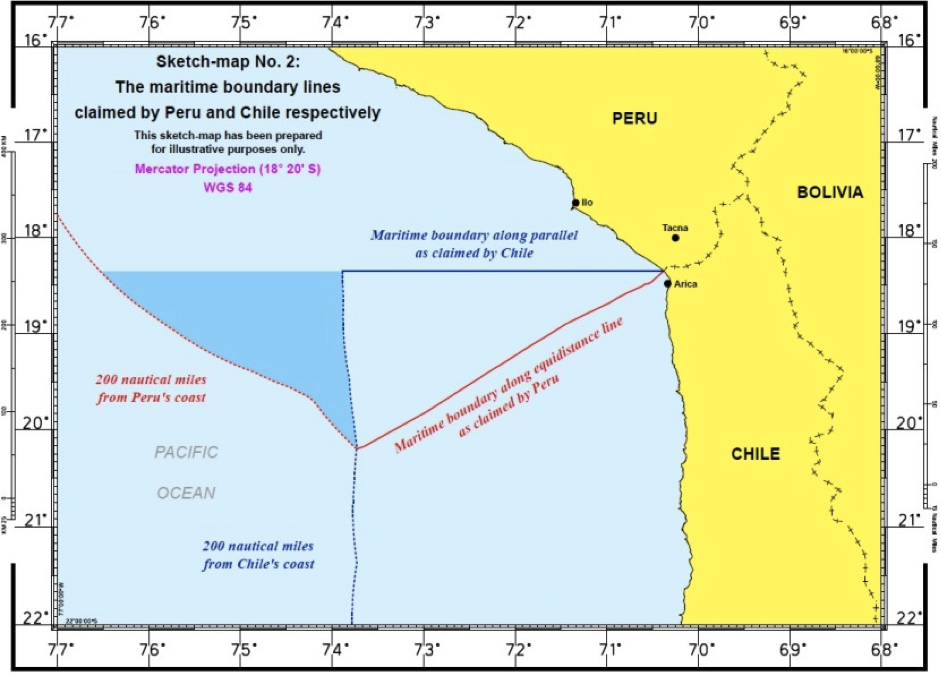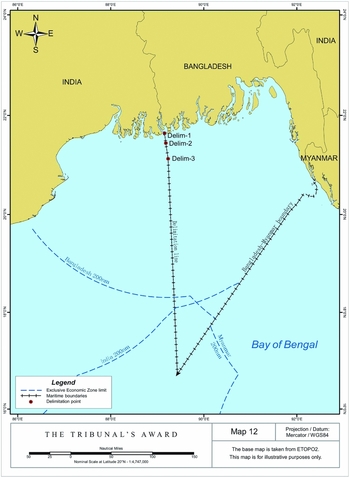Three-stage Approach of Maritime Delimitation that the International Court of Justice (ICJ) “has developed a settled jurisprudence relating to the interpretation of those provisions”, while quoting the Court’s description of the three-stage approach of first drawing a provisional delimitation line, then assessing that line in the light of the relevant circumstances of the case and finally applying the disproportionality test to determine whether the proposed boundary results in an equitable solution, which has been developed in the context of the delimitation of the continental shelf and the exclusive economic zone. “international law thus calls for the application of an equidistance line, unless another line is required by special circumstances”. However, the assertion that the ICJ’s three-stage approach is settled jurisprudence in relation to article 15 is not borne out by a reading of the judgments. The quotation in paragraph 999 of the Award is from the judgment of the Court in Peru v. Chile. As the Award indicates, the Court in this connection makes reference to its earlier decisions in Black Sea and Territorial and Maritime Dispute (Nicaragua v. Colombia). All three decisions discuss the three-stage approach in relation to the delimitation of the exclusive economic zone and the continental shelf and there is nothing in these judgments suggesting that the Court considered that the three-stage approach applies equally to the delimitation of the territorial sea under article 15 of the Convention.
It must be suggested that there is a need for the harmonization of the methods for the delimitation of EEZ and CS, and the preferences of the Parties to the delimitation effected by an SMB and the emphasis on objectivity by international courts and tribunals in the maritime delimitation cases have led to the clarification and refinement of the rule and methods of delimitation. As indicated, the three-stage approach outlined in the Black Sea case reflects the achievement of the decisions of international courts and tribunals in this field and has been referred to in subsequent cases. Moreover, in most precedents, international courts and tribunals have used the equidistance or median line as a provisional delimitation line. It is true that this approach has not obtained the status of a customary international legal rule. However, as far as there is no compelling reason not to take the three-stage approach, it has become usual for an international court or tribunal to take this approach, as the Court indicated in the Caribbean Sea case.
International courts and tribunals preference for the three-stage approach and their emphasis on objective determination have influenced the relevant circumstances that are examined in the second stage. They have put the primary emphasis on the proportion of the coasts‟ lengths and the coastlines‟ geographical configuration, both of which can be examined objectively. At the same time, the geological conditions, the possibility of resources, and other subjective elements have not been approved as relevant circumstances in many cases.
It should also be noted that, since the Black Seas case, international courts and tribunals have specified the relevant area for delimitation and examined the proportion of the areas divided between the parties in the third stage, the stage for disproportionality test. The Court has already noted the importance of the “relevant area” in the context of the delimitation of a CS in the Tunisia/Libya case. However, it seems that by introducing the “relevant area” to be specified in the first stage and examined in the third stage, the Court examines the maritime delimitation not as the issue of a “line,” but rather as the division of the “maritime areas.” Moreover, international courts and tribunals have supported this approach in subsequent cases.
The Three-Stage Approach in the Decisions Rendered in 2014
In 2014, the Court rendered its Judgment in the Maritime Dispute (Peru v. Chile) and the Arbitral Tribunal rendered an Award in the Bay of Bengal Maritime Boundary Arbitration (Bangladesh/India).
(1) Maritime Dispute (Peru v. Chile), Judgment of 27 January 2014
In the Maritime Dispute (Peru v. Chile) case, the Court concluded that an agreed single maritime boundary existed between the Parties at 80 nautical miles long from the coast. With regard to the line beyond that point, the Court first noted that, while Chile had signed and ratified UNCLOS, Peru was not a party to it; while Chile claimed sovereignty and sovereign rights in pursuance with UNCLOS, Peru claimed a 200-nautical-mile “maritime domain,” which is used in its Constitution. As the Agent of Peru admitted that the notion of “maritime domain” as used in its Constitution was consistent with the maritime zones set out in UNCLOS, the Court considered it appropriate to proceed “on the basis of Articles 74, paragraph 1, and 83, paragraph 1, of UNCLOS which, as the Court has already recognized, reflect customary international law.” The Court then stated that “[t]he methodology which the Court usually employs in seeking an equitable solution involves three stages” and that “[i]n the first, it constructs a provisional equidistance line unless there are compelling reasons preventing that.” The Court noted that the case before it was unusual in that the starting-point for delimitation is located much further from the coast. The Court, however, stated that “[t]he usual methodology applied by the Court has the aim of achieving an equitable solution” and proceeded to the construction of a provisional equidistance line starting at the endpoint of the existing maritime boundary. The Court then determined the base points and the provisional equidistance line. With regard to this line, the Court concluded that there was no relevant circumstance that required the adjustment or shift of that line and that this conclusion caused no significant disproportionality.
(2) Bangladesh/India, Award of 7 July 2014
In the Bangladesh/India case, Bangladesh referred the dispute to compulsory arbitration, as called for under Part XV of UNCLOS, to which India responded. As far as the maritime delimitation was concerned, the Parties did not explicitly mention the delimitation effected by an SMB, but they did claim one line for the delimitation of territorial seas, the EEZ and CS within and beyond 200 nautical miles in their final submissions. In response to these submissions, the Tribunal first determined the delimitation line for the territorial seas. It then proceeded to the delimitation beyond the territorial seas and separated the examination of the delimitation line of the EEZ and CS within 200 nautical miles without distinguishing the EEZ from the CS and that for CS beyond 200 nautical miles. This section will take up the delimitation of EEZ and CS.
The Parties took different views with regard to the proper methodology for the delimitation of the EEZ and CS within 200 nautical miles. While India supported the three-step approach and equidistance/relevant circumstances method, Bangladesh preferred the angle-bisector method. The Tribunal found that the three-stage approach and equidistance/relevant circumstances method ensured “a high degree of transparency” in comparison to the angle-bisector method. It also stated that the “equidistance/relevant circumstances method is preferable unless, as the International Court of Justice stated in Nicaragua v. Honduras, there are „factors which make the application of the equidistance method inappropriate.‟”
In addition to taking the equidistance/relevant circumstances method, it should also be noted that the Tribunal identified the relevant area for delimitation before it decided the provisional line. Moreover, the identified relevant area played an important role in the examination of the disproportion test. This approach is very similar to that taken by the ICJ in the Black Sea case and by the ITLOS in the Bangladesh/Myanmar case.

in Peru and Chile case, The Court addressed the delimitation of the boundary beyond Point A following its three-step method it has established to help reach an equitable delimitation. At the first step – the application of the equidistance principle – the Court constructed a provisional equidistance line, drawing a circle with an 80 nm radius from Point A, in order to determine the relevant base points on the Peruvian coast. This equidistance line was extended out to 200 nm from the Chilean coast (to Point B). The Court did not find it necessary to address the submission of Peru regarding the “outer triangle” because it did not arise. The delimitation of the Parties’ overlapping maritime entitlements beyond Point A was by way of an equidistance line and it did not present an “outer triangle.” Thus, the Peruvian entitlement by virtue of the maritime boundary extends south of Point B to Point C for approximately 22 nm following the 200 nm limit of Chile.
At the second step – the consideration of other relevant circumstances that might alter the provisional equidistance line – the Court found that there were no relevant circumstances calling for adjustment of the provisional equidistance line.
At the third step – proportionality analysis – the Court examined whether the result achieved was significantly disproportionate in relation to the lengths of the relevant coasts. The Court noted that the object of delimitation was to achieve an equitable result, not an arithmetical equal apportionment of maritime areas. In this case, the existence of an agreed boundary running along a parallel for 80 nm made the calculation of the relevant coastal length and coastal areas “difficult, if not impossible” (Peru v. Chile, para. 193). The Court, accordingly, did not calculate any sort of precise ratios of entitlement, but instead broadly assessed the proportionality of the delimitation and concluded no significant disproportionality existed that militated against the equitable nature of the provisional equidistance line beyond Point A (Peru v. Chile, para. 194).

What is a delimitation agreement?
DELIMITATION OF RESPONSIBILITIES AGREEMENT means an agreement approved by both parties that defines the responsibilities related to quality, compliance, regulatory, and manufacturing to assure the Bulk Product is manufactured according to all applicable regulations and guidelines.

